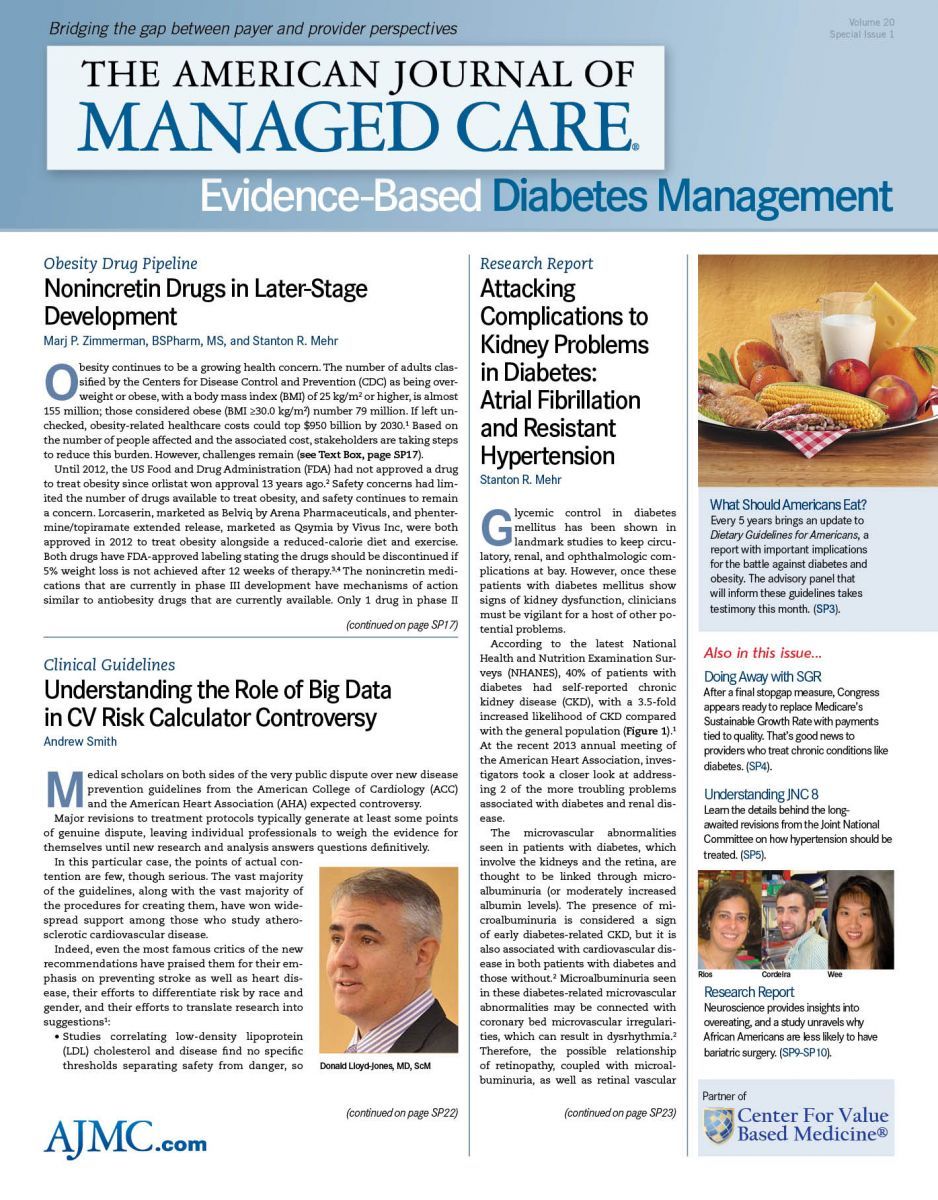- Center on Health Equity & Access
- Clinical
- Health Care Cost
- Health Care Delivery
- Insurance
- Policy
- Technology
- Value-Based Care
Getting an Earlier Diagnosis of Diabetes Starts With Better Screening
Conference Coverage: Diabetes Innovation
A pproximately 79 million people in the United States have prediabetes. Assessing the success or failure of diabetes prevention efforts, therefore, requires a closer look at screening, according to Richard S. Beaser, MD, associate clinical professor of medicine, Harvard Medical School, and medical executive director, professional education, Joslin Diabetes Center.
Beaser moderated a session on improving diabetes prevention at Diabetes Innovation 2013, which Joslin held October 3-5 in Washington, DC.
Panelists included: Christopher Porter, senior director, government affairs, Novo Nordisk; John E. Anderson, MD, president, medicine and science, American Diabetes Association (ADA); Stephanie Mayfield, MD, FCAP, commissioner, Department for Public Health, Commonwealth of Kentucky; and Ann M. Sheehy, MD, MS, associate professor, University of Wisconsin School of Medicine and Public Health.
The discussion began with ideas to promote broader diabetes screening efforts, so that more people can be diagnosed at an early stage to prevent further complications. The 2 most widely used diabetes treatment guidelines in the US, the ADA guidelines and the US Preventive Services Task Force (USPSTF) guidelines, have divergent criteria for diabetes screening (see Text Box).
“It starts with how we screen,” Sheehy said. She noted that the USPSTF, which bases its screening recommendation on blood pressure, is widely used, but fails to capture a large number of at-risk patients. Anderson agreed, adding that USPSTF guidelines need updating. Another issue in diabetes screening and prevention is the large number of people who have prediabetes and are unaware of it.
Thousands of individuals with prediabetes have received help with implementing lifestyle changes through programs such as the Diabetes Prevention Program (DPP) by the Centers for Disease Control and Prevention (CDC), but this represents a small fraction of the total population of those with prediabetes. Anderson added that the evidence shows that prevention efforts, such as the DPP, are largely effective.
“Prevention works, and it has longevity,” he said. “There is something very motivating about giving people an opportunity to prevent a disease.” The YMCA has a program similar to the DPP, and it focuses on people who have prediabetes at the community level. It promotes lifestyle changes and is low cost. Such a program essentially “meets patients where they are,” Anderson said.
Panel members agreed that one of the challenges with increasing participation in these programs is getting people to “show up” so they can be screened. Anderson said, “We are not waiting for (a glycated hemoglobin of) 6.5, we have opportunities here.”
Having the right policies in place that promote access and wellness is important. Implementation of the Affordable Care Act (ACA) should improve access to care, according to Mayfield. Healthcare exchanges have generated great interest in Kentucky, whose large numbers of uninsured were the main reason Governor Steve Beshear opted to expand Medicaid.
“Kentucky ranked 30th in health insurance,” Mayfield said. “About 640,000 of the 4.3 million residents don’t have health insurance.” Diabetes, which is prevalent in Kentucky, has more than tripled since 1995, she said. Porter agreed that policy is critical, and that diabetes needs to be a national priority. The ACA requires coverage of preventive services with a USPSTF A and B-rated recommendation, which is a step in the right direction. However, the fact that the USPSTF guidelines recommend screening based on elevated blood pressure is a problem. “No one in this room thinks we should wait for people to have hypertension before we screen them for diabetes,” Porter said.
Unless policy makers are involved in diabetes prevention, he added, “we will leave a lot of opportunity on the table.” Beaser asked the panel to comment on how barriers to prevention can be identified, and how information technology can help. Anderson spoke first. He noted that there are many ways to deliver prevention programs or encourage screening electronically. Mayfield agreed. “Technology is crucial,” she said. She noted that being able to track emergency department visits among those who are at the high end of the spectrum for utilization has already provided a wealth of information to her department. The next step is to use the technology for those who are not “super utilizers.”
Clinicians, Beaser said, need to be more aggressive in their approach. They should do more than just tell their patients to exercise and watch what they eat, he said. Physicians play an important role and should make sure patients fully understand the metabolic consequences of even a slight variance outside of the normal range of some of the clinical markers associated with diabetes. “Knowledge is an important starting point,” he stated. Beaser then asked the panel for their thoughts on the best way for physicians to educate patients.
Mayfield said that local health departments have diabetes health educators who can provide support to the physicians in the community. In her department, the health educators visit local physicians and offer assistance with patient education. “Local health departments have been a valuable and untapped resource,” she said.
“Part of our strategic plan is to educate providers to be relentless in bringing patients back in for follow-up,” Anderson told attendees. In order for this to happen, however, it needs to be easier for primary care physicians to provide more depth in their care and for patients to have greater access to that depth.

Health Outcomes of Dually Eligible Beneficiaries Under Different Medicare Payment Arrangements
December 1st 2025Within the same physician groups, 2-sided risk in Medicare Advantage (MA) was associated with higher quality and lower utilization for dually eligible beneficiaries compared with fee-for-service MA and traditional Medicare.
Read More
Exploring Pharmaceutical Innovations, Trust, and Access With CVS Health's CMO
July 11th 2024On this episode of Managed Care Cast, we're talking with the chief medical officer of CVS Health about recent pharmaceutical innovations, patient-provider relationships, and strategies to reduce drug costs.
Listen
